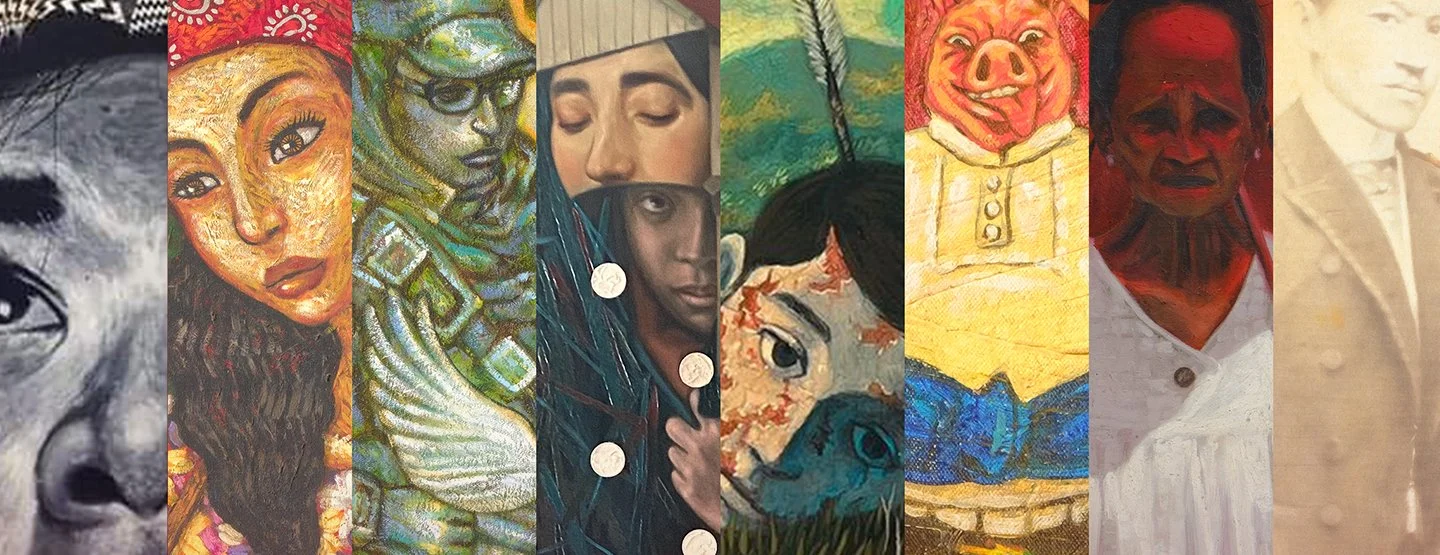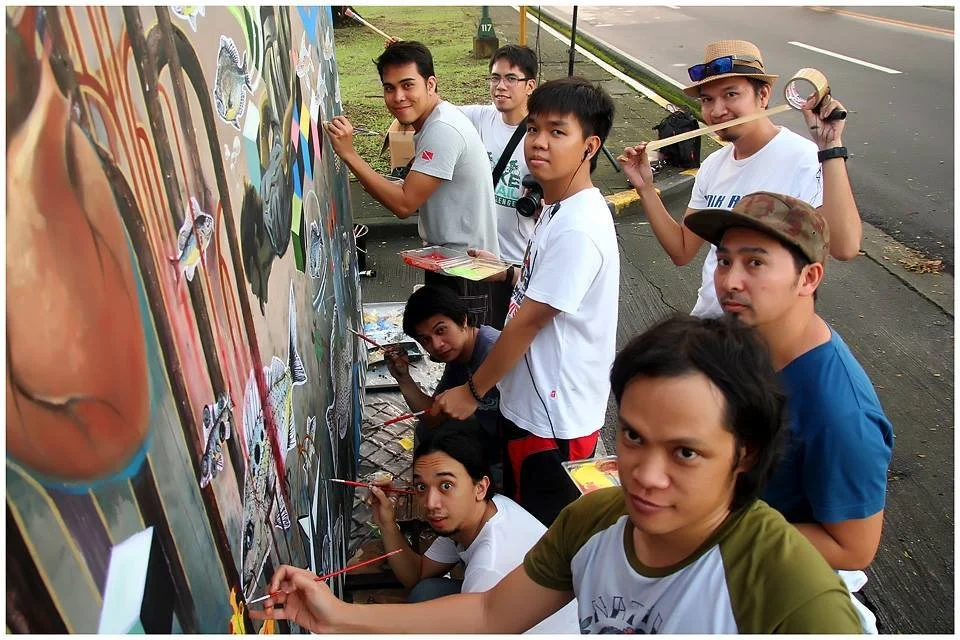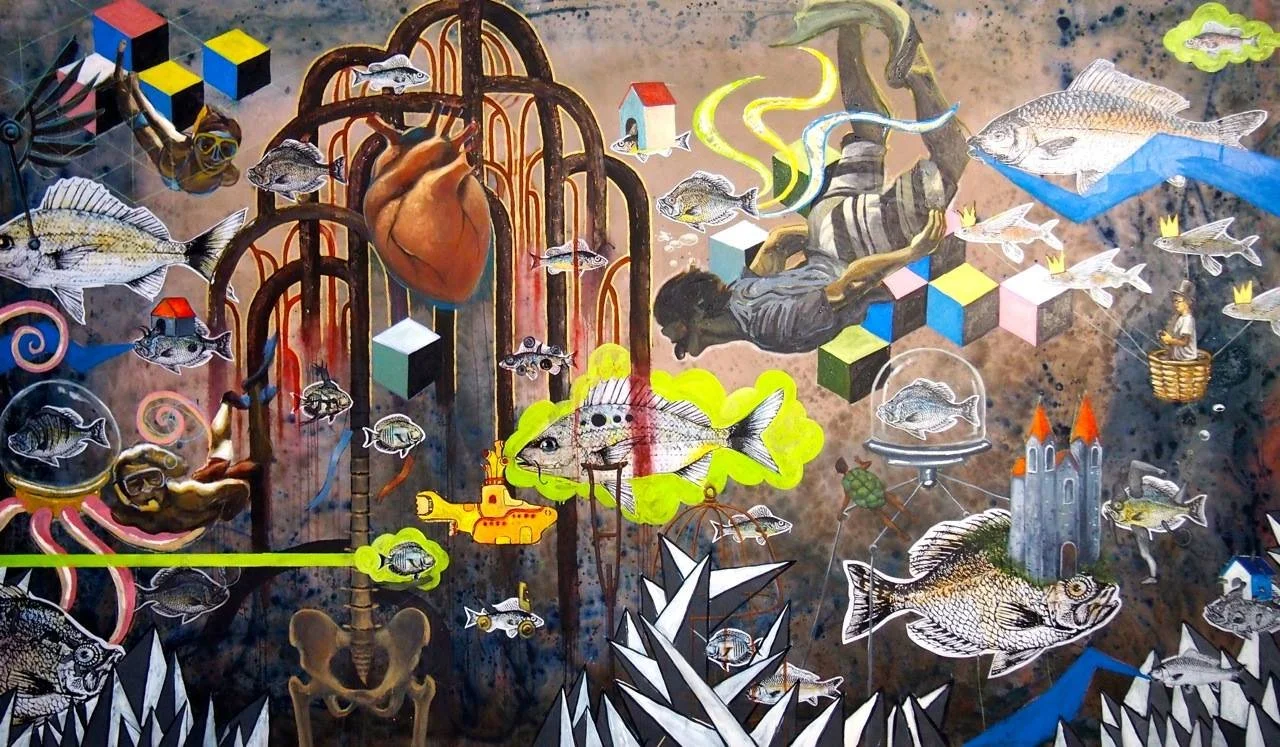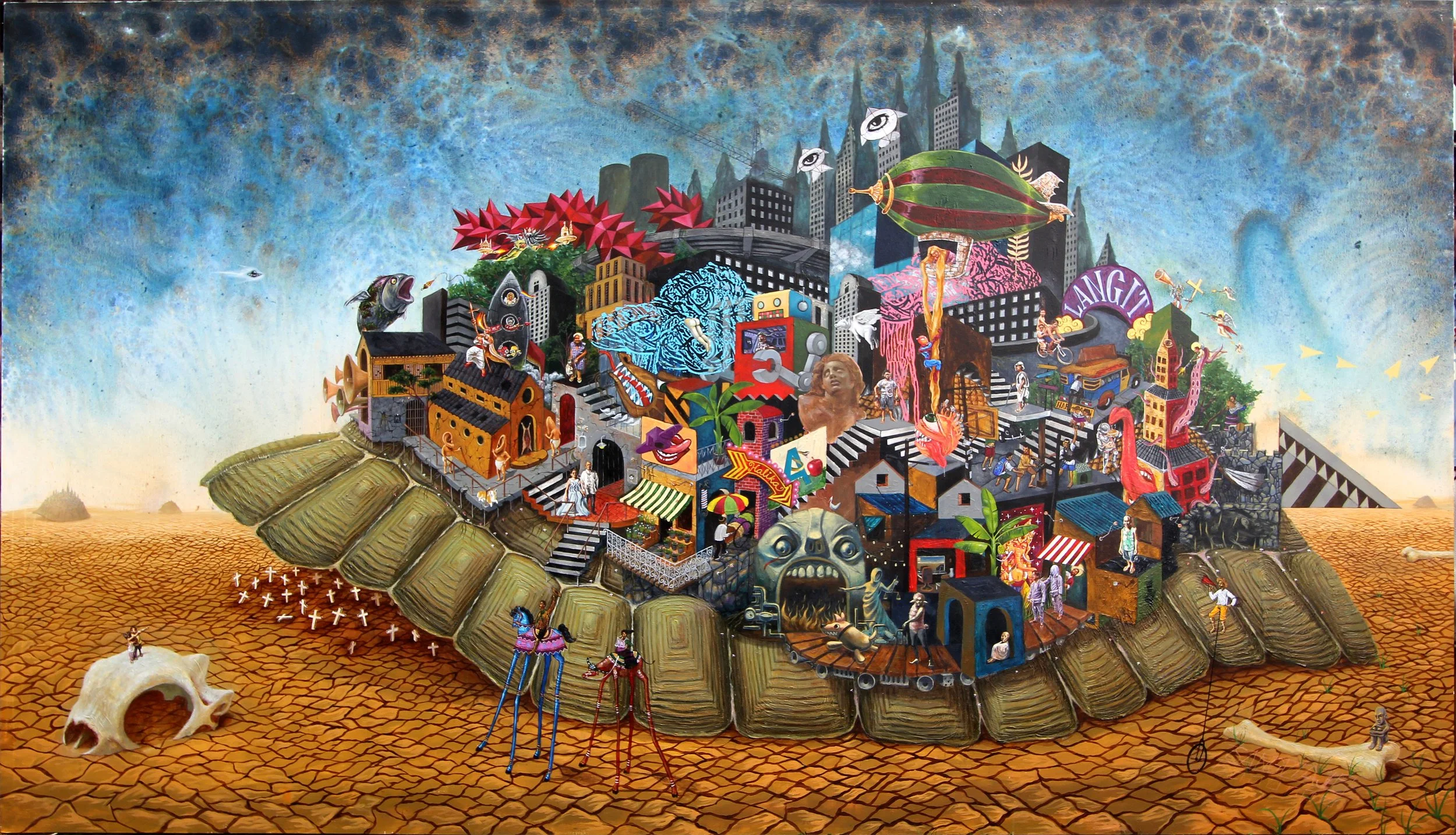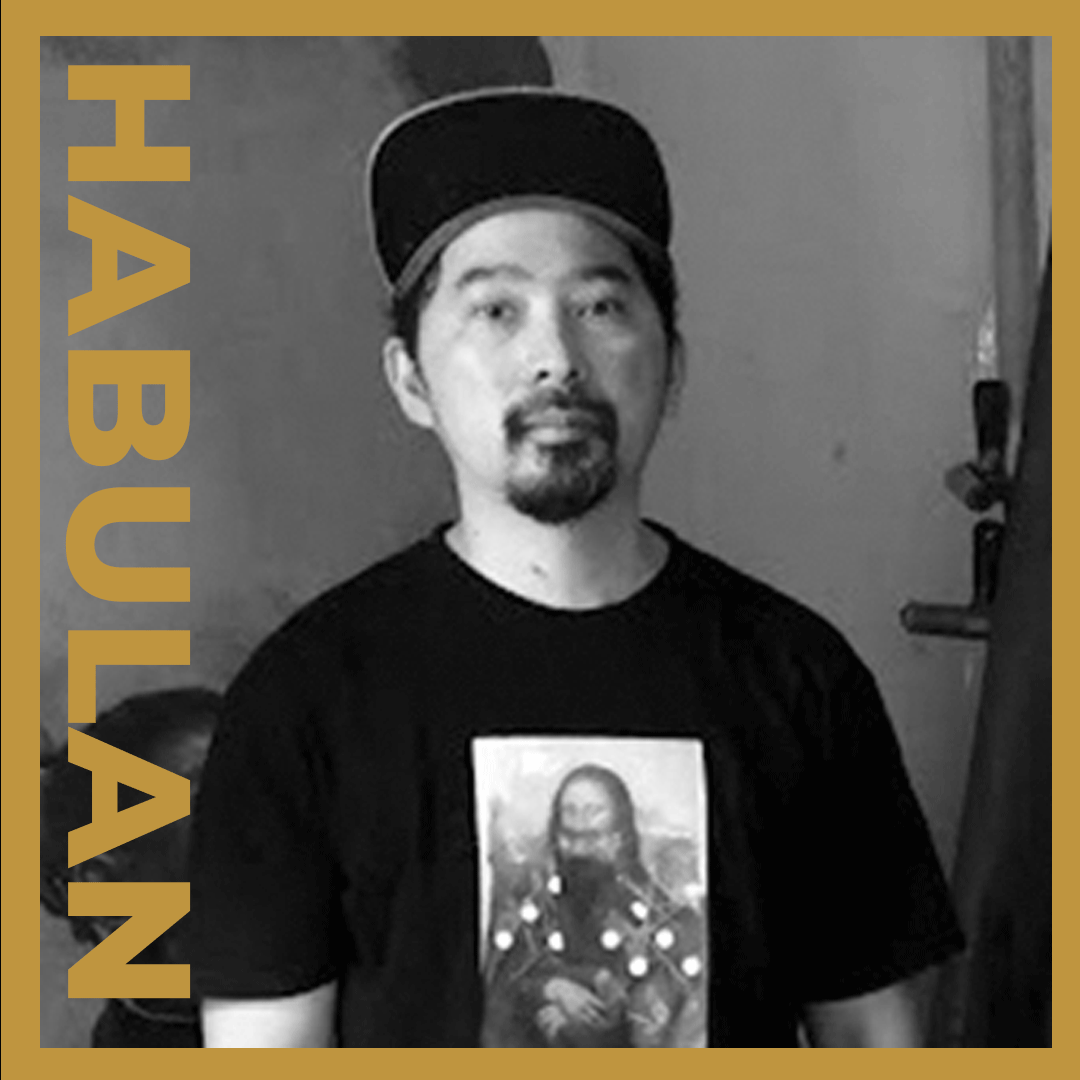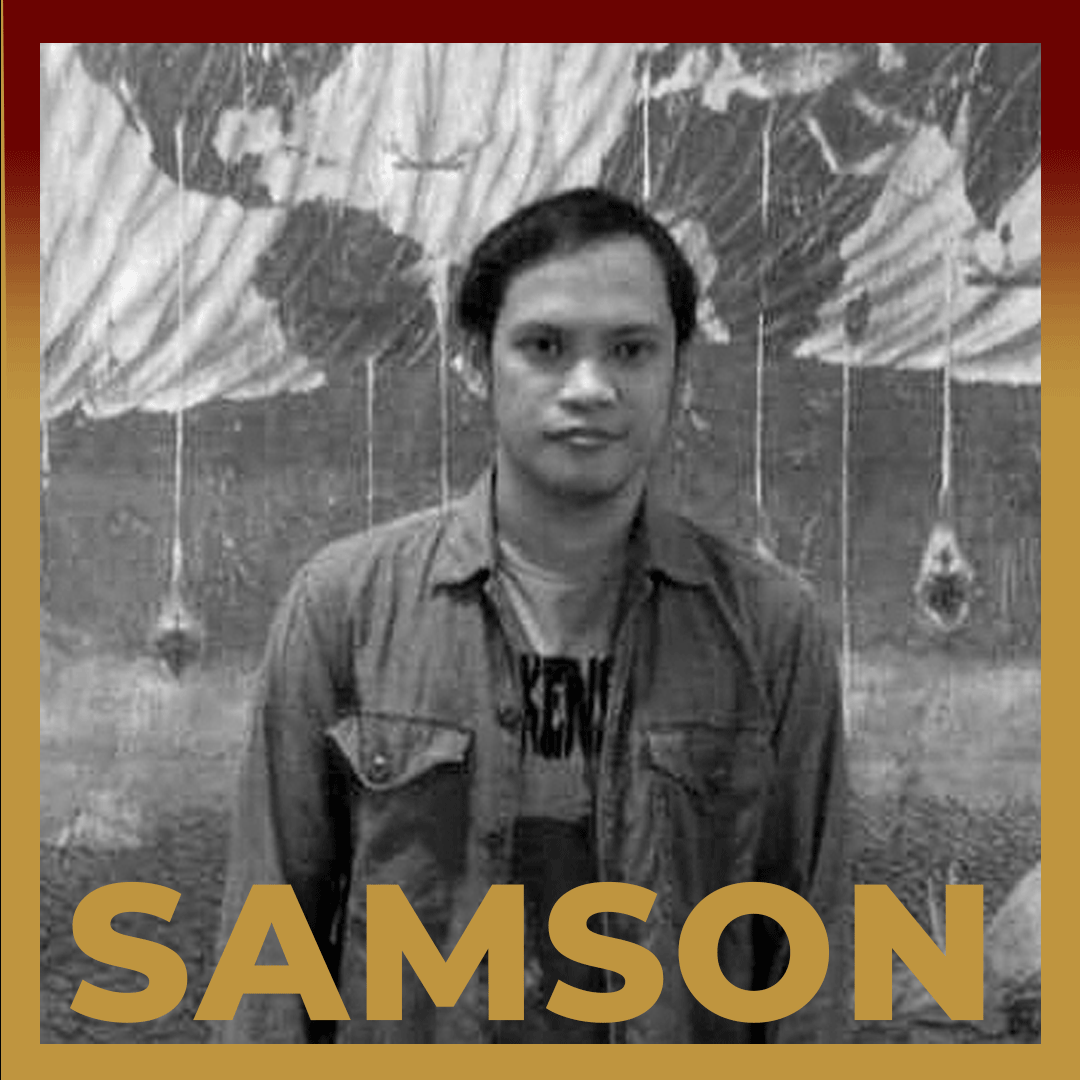REDISCOVERY:
SANGVIAJE
KampoArtes is proud to present its inaugural showcase, REDISCOVERY: SANGVIAJE, which traces the artistic evolution of the Antipolo-based collective. Opening on October 22, Sunday, the exhibition unveils a veritable survey of works that the Sangviaje members accomplished at different points in their respective careers, providing a glimpse on their individual development as well as the stylistic and thematic similarities that bound these artists together.
Sangviaje, which emerged in the early 2000s when most of its members were still students at the College of Fine Arts of the University of the Philippines, Diliman, is composed of John Paul Antido, Edrick Daniel, Dennis Fortozo, Guerrero Habulan, Joven Mansit, and Jaypee Samson. This formidable lineup was later enriched by the inclusion of Daniel Aligaen and Pogs Samson.
Sangviaje creating the “HABITAT” mural in Vargas Museum, UP Diliman
Mentored by Jerson Samson and the Salingpusa members, who were already some of the most dominant voices as they were starting, the artists of Sangviaje sought to carve a niche in the art scene by contemplating, imagining, and rendering socio-political concerns amid other pressing issues of the 21st century that included globalization, migration, and post- colonialism.
The works on display, curated by Jim Orencio, exemplify the breadth and depth of visions of the Sangviaje members. For instance, Daniel explores the interiority of man and how it shapes his external reality. Antido, on the other hand, explores contemporary culture shaped by colonial history and tradition. Habulan’s aims, meanwhile, include in exposing the influence of globalization on Philippine identity.
For Mansit, his use of old, turn-of-the-century photographs juxtaposed with symbols from modernity underscores the malleable quality of history. Jaypee Samson, who also uses photographs as basis for his compositions, presents the tender-hearted aspirations of those from the margins. His brother, Pogs, critiques the power of the church and the government on the day-to-day lives of Filipinos. Aligaen, known for his labyrinthine works, provides multiple views of the world through an altered state of consciousness. Last, Fortozo unpacks militaristic incursions in common life and everyday vocabulary.
HABITAT by Sangviaje, 7x12 feet, commissioned by CANVAS to promote Project Bakawan.
During the opening, members of Sangviaje, led by Antido and Daniel, will share their reflections on the various aspects of the collective: from its genesis to its local and international exposures to its collaborations that included murals, installations, and other projects. Of particular interest would be the shared ideology of its members who, despite their commitment to their respective art careers, still come together as a group for worthwhile initiatives.
As KampoArtes proudly unveils Rediscovery: Sangviaje, an unprecedented compendium of the collective’s works, the gallery seeks to contribute to the discourse on how art collectives are formed, their influence on culture, and how they testify to the power of artistic collaboration and the transformative nature of shared visions.
“Ang Patuloy na Pag-usap ng Lipunang May Sayad” 152 cm x 122 cm, acrylic on canvas, 2017
Video courtesy of Sangviaje and CANVAS (www.canvas.ph)
MEET THE ARTISTS
Daniel Aligaen invites the viewer into a mesmerizing exploration of diverse perspectives through his intricate and labyrinthine artworks, transcending conventional boundaries of figuration and guiding them into an altered state of consciousness. His creations are complex tapestries of meaning, woven with a rich array of visual allusions and layered, intimate representations. His artistic practice is akin to a mythic quest, delving into the profound philosophies surrounding the cycles of life and the gateways leading to preternatural realities.
Derived from keen observations of the world around him, Aligaen infuses his works with slices of lived events and magnified glimpses into the intricacies of human habits and experiences. However, his artistic pursuits extend beyond the realm of the visible. Aligaen finds joy in manipulating the aesthetics of geometric patterns, seamlessly integrating them into his creations. This deliberate interplay of diverse elements serves as a hallmark of Aligaen’s artistic expression.
John Paul Antido paints vivid tapestries of the Filipino experience through a distinctive style that seamlessly weaves together elements of Filipiniana, children’s books’ illustrations, turn-of-the-century aesthetics, and surrealism. His thematic exploration revolves around the interconnectedness of geography, identity, and the dynamism of Filipino culture.
Antido’s works often depict the archipelagic nature of the Philippines not as fixed points on a map but as vessels of mobility, capturing the essence of a people deeply rooted in migration. His figuration reflects the dreams and aspirations of Filipinos, metaphorically tethered to their homeland while dispersed globally. The artist portrays the Filipino experience as both geographic and imaginary, emphasizing a shared national identity forged through a sense of community. His thematic consistency across exhibitions offers a poignant commentary on the enduring aspects of the Filipino experience, celebrating shared heritage, and exploring the choices that shape individual and collective identities.
Edrick Daniel delves into the complexities of Filipino identity, employing a nuanced visual language to explore the tensions and contradictions inherent in the quest for a coherent sense of nationhood. In a nation grappling with post-colonial narratives and conflicting definitions of identity, Daniel’s work becomes a reflection on the struggles and aspirations of the Filipino people.
His exploration begins with a desire for a tangible and well-defined concept of the Philippines, a collective history that transcends post-colonial influences. The artist navigates this longing through both tentative and bold strokes, probing questions of autonomy, sovereignty, and nationhood. In essence, Daniel’s art becomes a visual discourse on the multifaceted nature of Filipino identity, grappling with historical influences, post-colonial struggles, and the evolving complexities of contemporary life. His paintings serve as a mirror to the introspective journey of a nation seeking to define itself amidst a backdrop of contradictions.
Dennis Fortozo, based in Cagayan, is a storyteller whose works assume the quality of modern-day fables. In his distinctive artistic narrative, seats of power are represented by animals, offering a thought-provoking allegory that exposes the dangers of mass surveillance and militarization. Fortozo skillfully reveals, through an all-over approach where conventional perspectives are eschewed in favor of activating the totality of the pictorial space, how easily individuals surrender their human rights in exchange for a fragile sense of peace and security.
Fortozo’s art delves into pressing environmental issues, particularly the degradation of the countryside resulting from humanity's insatiable demand for natural resources. His canvases depict a stark reality where tanks and missiles loom over the landscape, symbolizing the forceful appropriation of these resources. His ability to fuse symbolic storytelling with a critical examination of contemporary issues compels the viewer to engage with the narratives he unfolds on canvas.
Guerrero Habulan consistently exposes the intricate interplay of contradictory forces shaping the Philippine reality by combining different figurative styles and approaches—from hyperrealism to pop surrealism to the “ready-made” images of silkscreen printing. Habulan’s signature method allows him to synchronously present layers and dimensions that otherwise would have been invisible. What the viewer gains is an insight into how identities are never fixed and settled but are continuously prone and open to influence and contestation.
Each of his paintings captures the layered complexities of the nation’s economic, socio-political, and cultural dimensions, amalgamated with influences from colonial history, market forces, and globalization. In a recent exhibition, Habulan highlights societal functioning during the pandemic as well as our perception of vulnerabilities and strengths. He employs allegories and symbolism to mirror the seductive surface of spectacle, challenging the viewer to question their complicity and consider meaningful action in the face of societal transformations.
Joven Mansit is notable for works characterized by a sepia-toned aesthetics reminiscent of fin de siècle Filipiniana photographs. Initially, Mansit’s style appears firmly rooted in appropriation, skillfully translating photographic nuances into the realm of painting. Yet, upon a more intimate inspection, the intricacies of his works reveal themselves—manifesting in divergent and dissociative elements. These include a pair of horns, bat wings, or the imposing carcass of meat disruptively juxtaposed against what might have been a tranquil and straightforward portrait.
The inclusion of these unexpected elements prompts an unsettling feeling on the part of the viewer, leading to an insight into the veracity of historical records and the deliberate intrusion by the artist to disrupt conventional assumptions and belief systems. Through his nuanced approach, Mansit challenges the viewer to question historical narratives, fostering a deeper understanding of the malleability and subjectivity inherent in the interpretation of the past.
Jaypee Samson investigates into the dynamics of portraiture, capturing the likenesses of family and friends, usually during their moments of pride and dignity, such as in the artist’s own graduation where he is depicted alongside his father, with the ubiquitous tricycle as background. His artistic signature is characterized by loose and open brushstrokes, lending a unique texture to his works. Employing a fish-eye lens perspective, Samson introduces intentional distortion to his portraits, challenging the perceived stability of identity within his subjects.
Under the scrutiny of Samson’s artistic gaze, his subjects are placed beneath tropical sunlight—a technique famously celebrated in Amorsolo paintings. This strategic use of light not only adds a squinting effect, altering facial expressions, but also serves as a deliberate departure from conventional portrayals. By subverting portraiture whose roots are deeply embedded in Western tradition, Samson plumbs into the complex intersection of identity, perception, and representation.
Pogs Samson ushers the viewer into post-apocalyptic scenarios of the world filled with weapons of mass destruction, astronauts and space craft, as well as images symbolic of power and corruption. His recent exhibition delved into the concept of “regenesis,” exploring the potential emergence of a new world event from the aftermath of cataclysmic events—akin to a fresh start spurred by global infections or wars.
Maintaining thematic consistency throughout his many exhibitions, Samson scrutinizes power dynamics between institutions and the people. His vivid artworks lay bare the ties between religion and global imperialism, foreshadowing potential destruction and doom. The artist boldly subverts religious iconography, emphasizing its status as a social construct and advocating for liberation from hollow institutions. His highly prophetic artworks stand as tablets, unveiling a world teetering on the brink and urging the viewer to confront the true evils of our time.
REDISCOVERY: SANGVIAJE
Art Talk: 22 October, Sunday, 3PM
Exhibition: 22 October to 8 November 2023
For inquiries, please email us at info@kampoartesgallery.com

